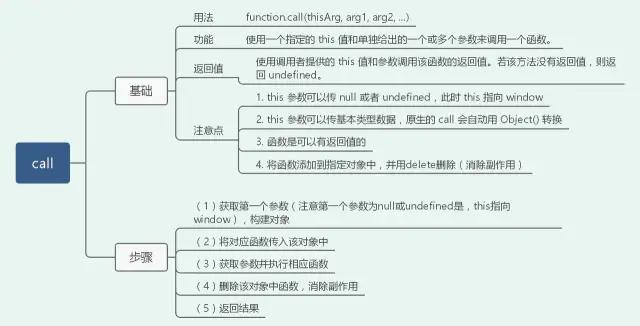您现在的位置是:首页 > Javascript
当前栏目
前端百题斩——快速手撕Call、Apply、Bind
2023-03-09 22:07:21 时间
在百题斩js中的这些“this”指向都值得了解中已经简要概述了call、apply、bind三个方法,这三者作用是相同的,均可以改变this指向,从而让某对象可以调用自身不具备的方法,本节将深入理解这三者的实现原理。
15.1 call()
15.1.1 基础
call() 方法使用一个指定的 this 值和单独给出的一个或多个参数来调用一个函数。其返回值是使用调用者提供的this值和参数调用该函数的返回值,若该方法没有返回值,则返回undefined。
基本用法:
- function.call(thisArg, arg1, arg2, ...)
小试牛刀
- function method(val1, val2) {
- return this.a + this.b + val1 + val2;
- }
- const obj = {
- a: 1,
- b: 2
- };
- console.log(method.call(obj, 3, 4)); // 10
15.1.2 实现
实现一个call函数,将通过以下几个步骤:
- 获取第一个参数(注意第一个参数为null或undefined时,this指向window),构建对象
- 将对应函数传入该对象中
- 获取参数并执行相应函数
- 删除该对象中函数,消除副作用
- 返回结果
- Function.prototype.myCall = function (context, ...args) {
- // 获取第一个参数(注意第一个参数为null或undefined时,this指向window),构建对象
- context = context ? Object(context) : window;
- // 将对应函数传入该对象中
- context.fn = this;
- // 获取参数并执行相应函数
- let result = context.fn(...args);
- // 消除副作用
- delete context.fn;
- // 返回结果
- return result;
- }
- // ……
- console.log(method.myCall(obj, 3, 4)); // 10
15.2 apply()
15.2.1 基础
apply() 方法调用一个具有给定this值的函数,以及以一个数组(或类数组对象)的形式提供的参数。其返回值是指定this值和参数的函数的结果。call() 和 apply()的区别是call()方法接受的是参数列表,而apply()方法接受的是一个参数数组;
基本用法
- func.apply(thisArg, [argsArray])
小试牛刀
- function method(val1, val2) {
- return this.a + this.b + val1 + val2;
- }
- const obj = {
- a: 1,
- b: 2
- };
- console.log(method.apply(obj, [3, 4])); // 10
15.2.2 实现
apply和call的区别主要是参数的不同,所以其实现步骤的call大体类似,如下所示:
- Function.prototype.myApply = function (context, arr) {
- context = context ? Object(context) : window;
- context.fn = this;
- let result = arr ? context.fn(...arr) : context.fun();
- delete context.fn;
- return result;
- }
- // ……
- console.log(method.myApply(obj, [3, 4])); // 10
15.3 bind()
15.3.1 基础
bind() 方法创建一个新的函数,在 bind() 被调用时,这个新函数的 this 被指定为 bind() 的第一个参数,而其余参数将作为新函数的参数,供调用时使用。该函数的返回值是一个原函数的拷贝,并拥有指定的this值和初始参数。
基本用法
- function.bind(thisArg[, arg1[, arg2[, ...]]])
小试牛刀
- function method(val1, val2) {
- return this.a + this.b + val1 + val2;
- }
- const obj = {
- a: 1,
- b: 2
- };
- const bindMethod = method.bind(obj, 3, 4);
- console.log(bindMethod()); // 10
15.3.2 实现
实现一个bind函数相对较复杂一些,应该注意以下几点:
- 能够改变this指向;
- 返回的是一个函数;
- 能够接受多个参数;
- 支持柯里化形式传参 fun(arg1)(arg2);
- 获取到调用bind()返回值后,若使用new调用(当做构造函数),bind()传入的上下文context失效。
- Function.prototype.myBind = function (context, ...args) {
- if (typeof(this) !== 'function') {
- throw new TypeError('The bound object needs to be a function');
- }
- const self = this;
- // 定义一个中装函数
- const fNOP = function() {};
- const fBound = function(...fBoundArgs) {
- // 利用apply改变this指向
- // 接受多个参数+支持柯里化形式传参
- // 当返回值通过new调用时,this指向当前实例 (因为this是当前实例,实例的隐士原型上有fNOP的实例(fnop);fnop instanceof fNOP为true)
- return self.apply(this instanceof fNOP ? this : context, [...args, ...fBoundArgs]);
- }
- // 将调用函数的原型赋值到中转函数的原型上
- if (this.prototype) {
- fNOP.prototype = this.prototype;
- }
- // 通过原型的方式继承调用函数的原型
- fBound.prototype = new fNOP();
- return fBound;
- }
本文转载自微信公众号「执鸢者」,可以通过以下二维码关注。转载本文请联系执鸢者公众号。
相关文章
- Java NIO学习笔记(一)Java NIO 概述
- Java GUI编程
- 手把手教你玩转 Kubeflow on EKS(三)
- Amazon EKS 集群升级指南
- 宣布推出 AWS IoT Greengrass 2.0 – 拥有开源边缘运行时和新的开发人员功能
- Java ServletContext 详解
- 构建自定义 Angular 应用程序以使用 Amazon SageMaker Ground Truth 标记作业
- 用于 Kubeflow Pipelines 的 Amazon SageMaker Components 介绍
- Java NIO 概述
- 开始使用开源 Web 会议解决方案 Jitsi
- Java NIO概述
- python3 requests简介
- 使用 EC2 Image Builder 实现 OS 映像构建管道自动化
- python3 xml模块
- 如何在 AWS 上构建并行文件系统 BeeGFS
- Python XML解析
- Java Script变量
- Python Flask,abort函数
- Amplify Framework 更新 — 快速为您的 Web 和移动应用程序添加机器学习功能
- 支持 Apache 软件基金会






